You are here
Middle Eastern and North African Immigrants in the United States

Mother and daughter of Middle Eastern background. (Photo: iStock/Phynart Studio)
Migration from the Middle East and North Africa (MENA) region to the United States has a longstanding and nuanced history. However, foreign and domestic developments following 9/11, including U.S. military involvement in Iraq, the ongoing civil war in Syria and consequent massive refugee exodus, and the Arab Spring uprisings have shaped U.S. public and policy perceptions in often negative ways toward migration from the region.
The first wave of migration from the region to the United States dates back to the late 1800s. Arab Christians from the Ottoman province of Syria (modern-day Lebanon, Israel, and Syria) largely fled economic insecurity, conscription, and religious persecution. A set of restrictive U.S. immigration policies in the 1920s, most notably the 1924 Johnson-Reed Immigration Act, ended the inflows despite ongoing conflict in the region. By 1920, the census recorded around 50,000 immigrants from the region resident in the United States, although another estimate ran as high as 123,000 in 1924.
The second period of significant arrivals (1948-1966) was mainly triggered by political instabilities in the region such as the 1948 Arab-Israeli War, which displaced an estimated 711,000 Palestinians, and revolutions in Egypt and Iraq. Most of these arrivals were Palestinian, followed by Egyptians, Iraqis, and Syrians. Due to restrictive U.S. immigration policies, this flow was smaller than the first and the arrivals were more highly educated.
The 1965 Immigration and Nationality Act ushered in the third period of significant migration of MENA immigrants to the United States. The law ended the stringent national-origins quota system that highly preferenced migration from Western Europe. MENA immigrants were motivated to migrate for varied reasons such as family reunification, economic and educational opportunities, and the need for humanitarian protection. A growing number also were Muslim, as compared to earlier periods of significant migration of MENA immigrants to the United States. Between 2000 and 2019, the immigrant population from the MENA region doubled from 596,000 to 1.2 million, representing a little less than 3 percent of the U.S. foreign-born population of 44.9 million as of 2019.
Figure 1. MENA Immigrant Population in the United States, 1980–2019

Sources: Data from U.S. Census Bureau 2010 and 2019 American Community Surveys (ACS), and Campbell J. Gibson and Kay Jung, “Historical Census Statistics on the Foreign-born Population of the United States: 1850-2000” (Working Paper no. 81, U.S. Census Bureau, Washington, DC, February 2006), available online.
Approximately 68 percent of MENA immigrants are from the Middle East and around 32 percent are from Northern Africa. Overall, Iraq and Egypt are the top countries of origin for MENA immigrants, followed by Lebanon, Syria, and Jordan (see Table 1).
Table 1. Distribution of MENA Immigrants by Country of Origin, 2019
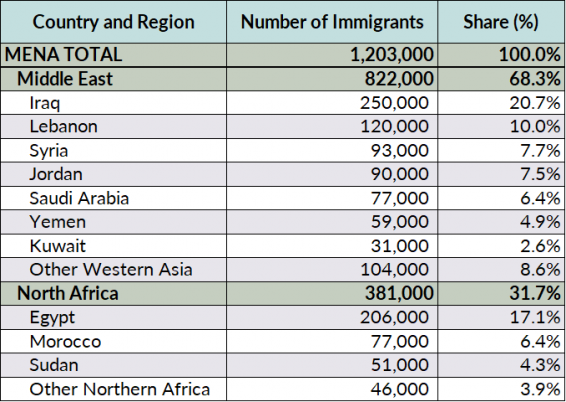
Source: MPI tabulation of data from the U.S. Census Bureau 2019 ACS.
Of the total 30.6 million MENA migrants worldwide in 2020, 46 percent (14.1 million) remained within the region, with Saudi Arabia (3.4 million), Jordan (3.3 million), and Lebanon (1.7 million) as the top regional destinations, according to mid-2020 estimates from the United Nations Population Division. Beyond the region, Turkey is the main destination (4 million) for MENA migrants and refugees, followed by France (3.3 million), and the United States and Germany (approximately 1.3 million each).
However, international settlement patterns vary considerably by country of origin. For example, of the 8.5 million Syrian migrants, 45 percent settled in Turkey, with Lebanon (12 percent) and Saudi Arabia (10 percent) as the second and third top destinations. Of the 3.6 million Egyptian international migrants, Saudi Arabia was the top destination (27 percent), followed by the United Arab Emirates (25 percent), and Kuwait (12 percent). The United States was the top destination for Iraqis (12 percent), followed by Turkey and Germany (11 percent each).
Click here to view an interactive map showing where immigrants from MENA countries and other countries have settled worldwide.
Within the United States, close to 30 percent of all MENA immigrants live in either California or Michigan. In 2019, they were less likely than other U.S. immigrant groups to have limited English proficiency, as well as more likely to be college graduates and to work in management, business, science, and arts occupations. Yet, they were more likely to live in poverty than other immigrants.
Using data from the U.S. Census Bureau (the most recent 2019 American Community Survey [ACS] as well as pooled 2015-19 ACS data), the Department of Homeland Security’s Yearbook of Immigration Statistics, and the World Bank, this Spotlight provides information on the MENA immigrant population in the United States, focusing on its size, geographic distribution, and socioeconomic characteristics.
Definitions
The U.S. Census Bureau defines the foreign born as individuals without U.S. citizenship at birth. The foreign-born population includes naturalized citizens, lawful permanent residents, refugees and asylees, legal nonimmigrants (including those on student, work, or other temporary visas), and persons residing in the country without authorization.
The terms “foreign born” and “immigrant” are used interchangeably and refer to those who were born in another country and later emigrated to the United States.
In keeping with the definition used by the International Organization for Migration (IOM), this Spotlight defines the Middle East and North Africa (MENA) region as: Algeria, Bahrain, Egypt, Iraq, Jordan, Kuwait, Lebanon, Libya, Morocco (and Western Sahara), Occupied Palestinian Territories, Oman, Qatar, Saudi Arabia, Sudan, Syria, Tunisia, the United Arab Emirates, and Yemen.
It is not possible to identify all countries of birth in the U.S. Census Bureau’s American Community Survey (ACS). Some responses fall into general categories (e.g., Tunisia and Western Sahara are grouped together under the category "Northern Africa, not elsewhere classified"), and some immigrants list "Asia, nec/ns" as their birthplace.
Click on the bullet points below for more information:
- Distribution by State and Key Cities
- Language Diversity and English Proficiency
- Age, Education, and Employment
- Income and Poverty
- Immigration Pathways and Naturalization
- Unauthorized Immigrant Population
- Health Coverage
- Remittances
Distribution by State and Key Cities
MENA immigrants are fairly dispersed throughout the United States. More than 50 percent reside in five states: California (18 percent), Michigan (10 percent), New York (9 percent), Texas (8 percent), and New Jersey (6 percent). The top seven counties for MENA immigrants—Los Angeles County, California; Wayne County, Michigan; Cook County, Illinois; San Diego County, California; Kings County, New York; and Macomb County, Michigan, and Harris County, Texas—together were home to one-quarter of the total MENA immigrant population in the United States.
Figure 2. Top States of Residence for MENA Immigrants in the United States, 2015–19
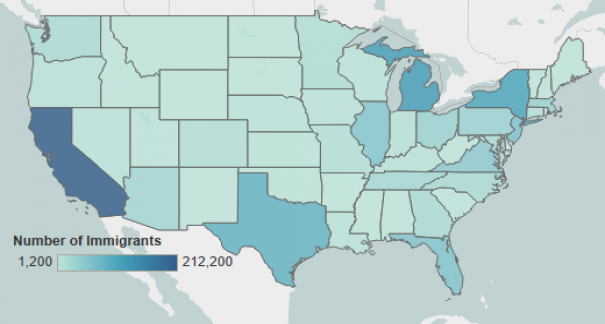
Note: Pooled 2015-19 ACS data were used to get statistically valid estimates at the state level for smaller-population geographies. Not shown are the populations in Alaska and Hawaii; for details, visit the Migration Policy Institute (MPI) Migration Data Hub for an interactive map showing geographic distribution of immigrants by state and county, available online.
Source: MPI tabulation of data from U.S. Census Bureau pooled 2015-19 ACS.
In the 2015-19 period, the U.S. cities with the largest number of MENA immigrants were the greater New York (13 percent), Detroit (9 percent), and Los Angeles (8 percent) metropolitan areas. About 30 percent of all MENA immigrants in the United States resided in these three metro areas.
Figure 3. Top Metropolitan Areas of Residence for MENA Immigrants in the United States, 2015–19
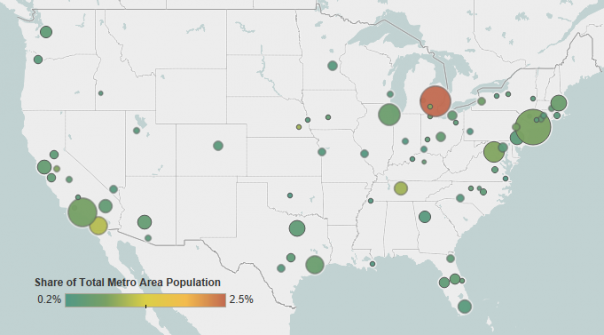
Note: Pooled 2015-19 ACS data were used to get statistically valid estimates at the metropolitan statistical-area level for smaller-population geographies.
Source: MPI tabulation of data from U.S. Census Bureau pooled 2015-19 ACS.
Click here to view an interactive map that highlights the metro areas with the highest concentrations of immigrants for MENA and other countries.
Table 2. Top Concentrations by Metropolitan Area for MENA Immigrants, 2015–19
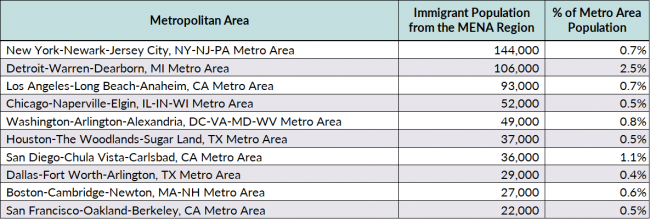
Source: MPI tabulation of data from the U.S. Census Bureau pooled 2015-19 ACS.
Language Diversity and English Proficiency
MENA immigrants are less likely to be Limited English Proficient (LEP) compared to the overall foreign-born population. In 2019, 39 percent of immigrants ages 5 and over from the MENA region reported limited English proficiency, compared with 46 percent of all immigrants. However, there were wide variations by country of origin: 50 percent and 47 percent of Syrian and Iraqi immigrants, respectively, reported limited English proficiency, compared to 28 percent of Lebanese immigrants.
Seventy-five percent of MENA immigrants spoke either Arabic or the Near East Arabic dialect, while 12 percent reported speaking only English. Speakers of French and Armenian accounted for about 3 percent each.
Note: Limited English proficiency refers to those who indicated on the ACS questionnaire that they spoke English less than “very well.”
Age, Education, and Employment
The age distribution of MENA immigrants is similar to that of the total foreign-born population: 11 percent were under age 18, 76 percent were between 18 and 64, and 13 percent were ages 65 and older. Both groups are older than the U.S. born. The median age for MENA immigrants in 2019 was 42, whereas it was 46 for all immigrants and 37 for the U.S. born.
Figure 4. Age Distribution of the U.S. Population by Origin, 2019
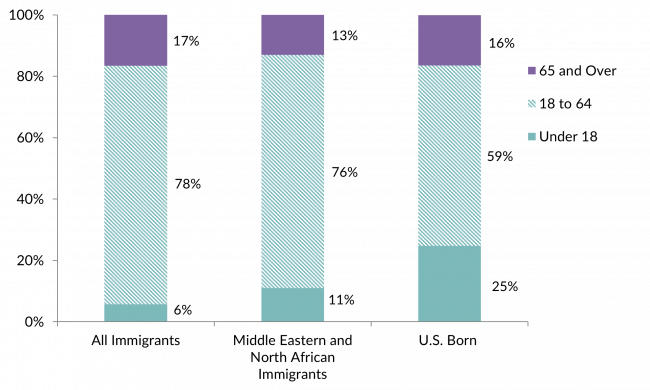
Source: MPI tabulation of data from the U.S. Census Bureau 2019 ACS.
Immigrants from the MENA region are far more likely to be highly educated than the total foreign- and native-born adult populations. In 2019, 46 percent of MENA immigrants ages 25 and older had a bachelor’s degree or higher, compared to 33 percent of all immigrant and U.S.-born adults. Among the MENA-origin population, the college-educated share ranges from 66 percent of Saudis to 43 percent of Lebanese and 33 percent of Iraqis. Just 14 percent of MENA immigrant adults lacked a high school diploma or equivalent, compared to 26 percent of all foreign-born and 8 percent of U.S.-born adults.
Many students from the MENA region choose to study in the United States. In the 2020-21 school year, 55,720 students from the region attended U.S. colleges and universities, according to the Institute of International Education (IIE). Saudi Arabia was the fifth top origin country among international students in the United States (after China, India, South Korea, and Canada), accounting for 3 percent (or 21,933) of the 914,095 international students during this period. Kuwait was also on the list of the top 20 sending countries: 6,846 Kuwaiti students studied in the United States that year.
While total international student enrollment declined by 15 percent between 2019-20 and 2020-21 in large part due to the COVID-19 pandemic, the number of MENA students dropped by 21 percent. MENA student enrollment has been declining every year since 2015-16 in part due to changes in home-country policies (e.g., the Saudi government scaling back its scholarship programs) as well as a less favorable immigration policy environment in the United States in recent years.
MENA immigrant adults (ages 16 and older) participated in the civilian labor force at nearly the same rate (61 percent) as U.S.-born adults (62 percent) versus 67 percent of all immigrants. A large share of MENA immigrants was employed in management, business, science, and arts occupations (43 percent) and in sales and office occupations (20 percent). They were less likely to work in natural resources, construction, and maintenance occupations (5 percent) compared to U.S.-born workers (8 percent) and immigrant workers overall (13 percent).
Figure 5. Employed Workers in the U.S. Civilian Labor Force (ages 16 and older) by Occupation and Origin, 2019

Source: MPI tabulation of data from the U.S. Census Bureau 2019 ACS.
Occupations varied considerably by country of origin. Immigrants from Saudi Arabia (69 percent), Lebanon (54 percent), and Egypt (49 percent) worked in management, business, science, and arts occupations. Twenty-nine percent of Syrians worked in sales and office occupations. Twenty-four percent of Moroccans were employed in service occupations.
MENA immigrants had significantly lower incomes compared to the total foreign- and native-born populations. In 2019, the median income of households headed by a MENA immigrant was $54,000, compared to $64,000 and $66,000 for all immigrant and U.S.-born households, respectively.
Furthermore, 22 percent of MENA immigrants in 2019 lived in poverty, compared to 14 percent of all immigrants and 12 percent of the U.S. born. The share in poverty varied widely among countries of origin from 14 percent of Moroccan immigrants to 26 percent of Iraqis to 34 percent of Saudis.
Immigration Pathways and Naturalization
Immigrants from MENA countries are more likely than the overall foreign-born population to be naturalized U.S. citizens. As of 2019, 62 percent of MENA immigrants were U.S. citizens, compared to 52 percent of the total foreign-born population.
MENA immigrants were more likely than the overall immigrant population to be recent arrivals, with 42 percent entering in 2010 or later, 23 percent entering between 2000 and 2009, and 35 percent entering prior to 2000. This trend varies by country of origin. For example, 71 percent of Saudis and 47 percent of Iraqi immigrants arrived in the last decade (2010-19), while 62 percent of Lebanese immigrants arrived before 2000.
Figure 6. MENA and All Immigrants in the United States by Period of Arrival, 2019
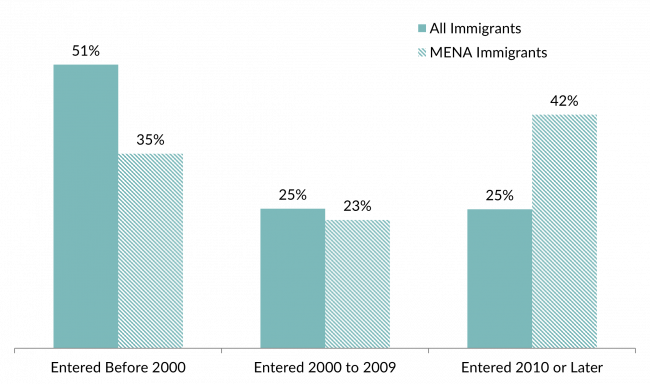
Source: MPI tabulation of data from the U.S. Census Bureau 2019 ACS.
Nearly half (49 percent) of MENA immigrants who in fiscal year (FY) 2019 became lawful permanent residents (LPRs)—also known as green-card holders—did so through familial ties as spouses, children, or parents of U.S. citizens, or through other family-sponsored preferences. To compare, 69 percent of all immigrants became LPRs through familial ties. Twenty-four percent of MENA immigrants obtained their green cards as refugees and asylees and 17 percent through the Diversity Visa lottery program. Unlike other MENA immigrants, most Iraqis and Syrians obtained their LPR status as refugees and asylees at 63 percent and 77 percent, respectively. Fifty-eight percent of Algerians and 42 percent of Sudanese became LPRs through the diversity visa lottery.
The largest share of new MENA green-card holders in 2019 was from Egypt (19 percent), followed by Iraq (13 percent), Syria (12 percent), and Jordan (10 percent). At the lower end of the spectrum, nationals of Bahrain and Oman each received fewer than 200 green cards.
Figure 7. Immigration Pathways of MENA Immigrants and All Lawful Permanent Residents in the United States, FY 2019
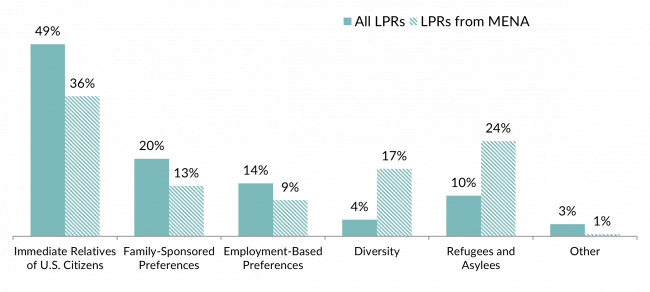
Notes: Immediate relatives of U.S. citizens includes spouses, minor children, and parents of U.S. citizens; Family-sponsored preferences includes adult children and siblings of U.S. citizens as well as spouses and children of green-card holders. The Diversity Visa Lottery was established by the Immigration Act of 1990 to allow entry to immigrants from countries with low rates of immigration to the United States. The law states that 55,000 diversity visas in total are made available each fiscal year.
Source: MPI tabulation of data from Department of Homeland Security (DHS), 2019 Yearbook of Immigration Statistics (Washington, DC: DHS Office of Immigration Statistics, 2020), available online.
Unauthorized Immigrant Population
The Migration Policy Institute (MPI) estimates that 45,000 unauthorized immigrants from MENA countries resided in the United States as of 2019, accounting for under 0.5 percent of all 11 million unauthorized immigrants in the country.
Click here for an interactive map of the 2019 unauthorized immigrant population in the United States.
As of September 30, 2021, 950 MENA immigrants were covered under the Deferred Action for Childhood Arrivals (DACA) program, representing a very small share of the nearly 611,030 active DACA recipients.
Click here to view the top origin countries of DACA recipients and their U.S. states of residence.
MENA immigrants were less likely in 2019 to be uninsured than the total foreign-born population (13 percent versus 20 percent). They were more likely to have private health insurance (53 percent) than public coverage (41 percent).
Figure 8. Health Coverage for MENA Immigrants, All Immigrants, and the U.S. Born, 2019
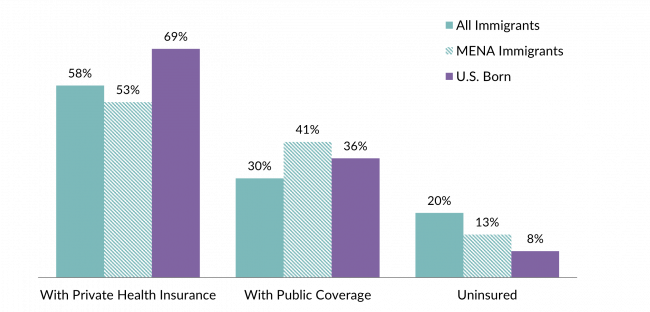
Notes: The sum of shares by type of insurance is likely to be greater than 100 because people may have more than one type of insurance.
Source: MPI tabulation of data from the U.S. Census Bureau 2019 ACS.
Global remittances to the MENA region increased by about 48 percent between 2010 and 2020, reaching $55.9 billion as of 2020, according to World Bank estimates. Among MENA countries, Egypt received the most remittances at $29.6 billion in 2020, followed by Morocco at $7.4 billion and Lebanon at $6.3 billion. Remittances represented a different share of each individual country’s GDP, ranging from under 1 percent for Iraq, Kuwait, Oman, and Qatar to 9 percent for Jordan, and 33 percent for Lebanon.
Figure 9. Annual Remittance Flows to MENA Countries, 1990-2020

Source: World Bank Prospects Group, “Annual Remittances Data,” May 2021 update, available online.
Sources
Foad, Hisham S. 2013. Waves of Immigration from the Middle East to the United States. Social Science Research Network, December 2013. Available online.
Gibson, Campbell J. and Kay Jung. 2006. Historical Census Statistics on the Foreign-Born Population of the United States: 1850-2000. Working Paper no. 81, U.S. Census Bureau, Washington, DC, February 2006. Available online.
Hooglund, Eric J. 1987. Crossing the Waters: Arabic-Speaking Immigrants to the United States Before 1940. Washington, DC: Smithsonian Institution Press, 27-33. Available online.
Institute of International Education (IIE). 2021. International Students: All Places of Origin. Washington, DC: IIE. Available online.
Orfalea, Gregory. 2006. The Arab Americans: A History. Northampton, MA: Olive Branch Press.
United Nations Population Division. 2020. International Migrant Stock 2020: Destination and Origin. Available online.
U.S. Census Bureau. 2020. 2019 American Community Survey. Accessed from Steven Ruggles, Katie Genadek, Ronald Goeken, Josiah Grover, and Matthew Sobek. Integrated Public Use Microdata Series: Version 11.0 [dataset]. Minneapolis: University of Minnesota. Available online.
---. N.d. 2019 American Community Survey—Advanced Search. Accessed January 5, 2022. Available online.
U.S. Citizenship and Immigration Services (USCIS). 2021. Count of Active DACA Recipients by Month of Current DACA Expiration as of June 30, 2021. Available online.
U.S. Department of Homeland Security (DHS), Office of Immigration Statistics. 2020. 2019 Yearbook of Immigration Statistics. Washington, DC: DHS Office of Immigration Statistics. Available online.
UN Conciliation Commission for Palestine. 1951. General Progress Report and Supplementary Report of the UN Conciliation Commission for Palestine; Covering the Period from 11 December 1949 to 23 October 1950. UN General Assembly report, Official Records: Fifth Session Supplement No. 18, New York, NY. Available online.
World Bank Prospects Group. 2021. Annual Remittances Data, May 2021 update. Available online.


